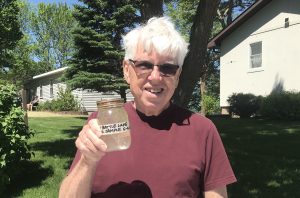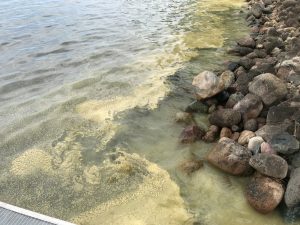WBLLA is Looking for Volunteers to Assist in Collecting Water Samples for Testing from West Battle Lake
Do you wish to help monitor our beautiful lake’s water?
WBLLA board member, Steve Slatten is currently the primary (and only) water sampling volunteer for West Battle Lake. But Steve would like help doing this task. Steve would be glad to share his insights and experience in doing this valuable task with anyone willing to help him perform this water monitoring.
Our lake has participated in a water quality monitoring program since 1997. The program uses the RMB Environmental Lab in Detroit Lakes to measure the amount of Phosphorus and Chlorophyll A in our lake water. Samples are collected once a month on specified days from May through September. The results are compiled in a database which enables trends in our water to be documented and available for future use. The benefit comes in being able to spot what may become problems and be able to react to them. Fortunately, our current West Battle Lake water quality is still ranked in the excellent rating.
All supplies and equipment are provided. There is a wealth of information including instructional videos on how to do the sampling on the RMB Lab website: www.rmbel.com/lakesmonitoringmain
If anyone has questions or would like more information, please contact Steve Slatten at Email: slate2359@comcast.net or Phone 612-803-7823

West Battle Lake Water Quality Readings Spring 2022
Click HERE to View / Download

What Was That Ugly Yellow Green Scum on The Lake in May of 2020?
Members of our WBLLA Board were asked similar questions: WBLLA Board Member Michael Smith and past Board President Jerry Horgen collected a water sample and Jerry Horgen took it up to RMB labs in Detroit Lakes for analysis.
Here is their Initial Response: We looked at the sample and did not see anything in there resembling algae. Jerry Horgen forwarded Michael Smith’s pictures and water sample to our Aquatic Plant Management Program Specialist and he thinks it’s pollen concentrated by the wind. He has seen similar scenes in other lakes during his inspections.
Jim Wolters, DNR Head of Fisheries
Click Photo to Enlarge
2021 West Battle Lake Water Quality Results WBLLA Sponsored
West Battle Lake Continues to Get Much Clearer
31 Feet Clarity on West Battle Lake in Early May!
Readings then went to mid 20 foot range mid summer
Normal Secchi Disk Readings in Past Years This Time of Year Would Average 15 to 17 Feet
What is the Cause?
Report from Jerry Horgen, WBLLA Past President
Bob Perry, Water Sampler for West Battle Lake has indicated a dramatic increase in our water clarity on West Battle Lake and John Hofflander, Secchi Disc Reader observed an increase as well. It’s due to zebra mussels being in our lake for four years. The water clarity, normally around 15.5 feet has increased to around 28 feet. I asked an Aquatic Ecologist from RMB Labs to answer the question as to “Why?” Elliie Kriese responded (Click on Link Below). Jerry Horgen also contacted Shannon Martin, the person who is in charge of water clarity (CLMP Program) at the Minnesota Pollution Control Agency and she indicated that the “increase” was normal with zebra mussels. There is no cure for zebra mussels at this time. The Minnesota Aquatic Invasive Species Research Center at the University of Minnesota is seeking to address this threat that is happening around the state of Minnesota. What is strange is that The Chippewa Valley Economic Research Group of Wisconsin published a study in 2016 entitled “The Impact of Water Clarity on Home Prices in Northwest Wisconsin” which indicated in its “Executive Summary” an actual increase in property values occurred due to water clarity.
Click HERE to See Article from RMB Labs
———————————–
Click HERE for 2019 West Battle Lake Water Quality Results
Readings Taken by John Hofflander – WBLLA Board Member
Secchi Disk Visibility Measured in Feet
Secchi disk: The secchi disk is a measure of water clarity. The standard secchi disk is a 8 inch diameter metal plate that is painted with an alternating white and black color pattern. The disk is lowered into the water until it disappears from view. The depth at which the disk can no longer be seen is the secchi depth that is recorded. Secchi disk readings can vary by season with the clearest water generally occurring in the spring, shortly after ice-out. Measurements are usually taken in the summer at the same time the fish sampling is occurring.
We typically get algae bloom that progresses as the summer heats up the water. Imagine 200 years ago there were very few inhabitants on the shores of our lake so it is very important that we encourage everyone to minimize anything that could drain into our lake, for example the remains of fires burned too close to the lake, anything that could impact our water quality.
DNR Tip – Fire Pits 50 Feet from Lake
What Lake Owners Can Do to Aid Lake Water Quality











